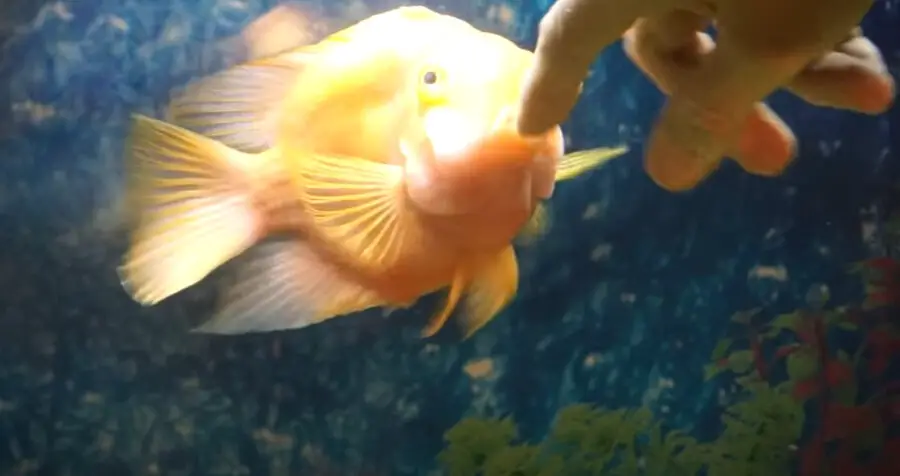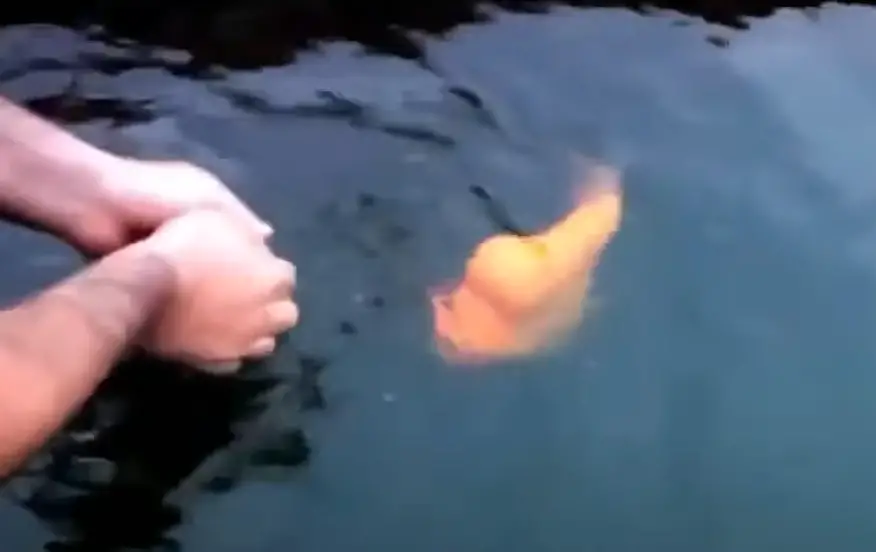Have you ever walked to your fish tank and wondered do goldfish recognize their owners?
If yes are they happy to see you (When its not feeding time) do they recognize your face?
Read on to find out.
Do Goldfish Recognize Their Owners
Goldfish are more intelligent and perceptive than we might think and it is still unsure if they do recognize us or not.
While goldfish may not possess the same level of recognition and cognitive abilities as mammals, they are capable of forming unique connections with their owners through visual recognition, associative learning, social bonding, and familiarity with auditory cues.

Goldfish can display behaviors that suggest recognition and respond to their owners’ presence. It’s important to spend quality time with your goldfish, provide a stimulating environment, and create positive associations to enhance the potential for recognition and bonding.
So, next time you approach your goldfish tank, observe their reactions closely you might just catch a glimpse of recognition in their sparkling eyes.
Do Goldfish Recognize Faces
While goldfish have excellent visual acuity and can distinguish between different objects, the extent to which they recognize faces is still a subject of debate. Unlike humans and some other animals, goldfish do not possess the same brain structures specifically designed for facial recognition.
They are capable of visual recognition and can learn to associate certain visual cues with positive experiences or familiar individuals, including their owners.
Goldfish primarily rely on their keen eyesight to detect movement, contrast, and patterns. They can discern differences in body shape, size, and color, which may allow them to recognize familiar faces to some degree.
For example, if you consistently approach your goldfish tank from a particular direction or wear distinct clothing, they may become accustomed to these visual cues and associate them with positive experiences, such as feeding or interaction.
Furthermore, goldfish are known for their ability to learn and remember. Through associative learning and conditioning, they can form connections between specific visual stimuli and positive outcomes. Over time, they can learn to associate their owners’ faces or certain visual features with feeding, attention, or other pleasurable experiences.
While goldfish may not possess the same level of facial recognition as humans or animals with more advanced cognitive abilities, their capacity for visual recognition and associative learning suggests that they can become familiar with their owners’ faces and respond to visual cues associated with positive interactions.

Are Goldfish Happy to See Their Owners
When their owners approach or interact with them, goldfish may display certain behaviors that can be interpreted as happiness or excitement. Here are some indications that goldfish may be happy to see their owners:
Increased Activity
Goldfish may become more active and swim energetically when their owners approach the tank. They may eagerly swim to the front of the aquarium, displaying enthusiasm and curiosity.
Feeding Response
Goldfish associate their owners with food, and when they see their owners, they may anticipate feeding time. They may swim excitedly and exhibit behaviors such as begging or searching for food.
Visual Recognition
Goldfish have excellent eyesight and can distinguish between different individuals. They may learn to recognize their owners based on visual cues such as body shape, size, or color. When they see their owners, they may exhibit specific behavioral responses indicating recognition or familiarity.
Interaction and Engagement
Goldfish may engage with their owners during feeding or other interactions. They may swim closer to the surface, interact with their owners’ fingers, or follow their movements. This interactive behavior can be seen as a positive response to their owners’ presence.
Positive Reinforcement
Goldfish are intelligent animals that can associate their owners’ presence with positive experiences. Through consistent care and rewarding interactions, goldfish can develop positive associations with their owners, leading to a sense of happiness or contentment when they see them.
It’s important to note that goldfish’s behaviors can also be influenced by other factors such as environmental changes, hunger, or curiosity. While we cannot fully understand the subjective experiences of goldfish, their responsive behaviors suggest a level of recognition and positive response to their owners’ presence.
Do Goldfish Show Affection
Goldfish are not known to display affection in the same way that humans or some mammals do. Affection, as we commonly understand it, involves complex emotions and behaviors that are often driven by social bonds and attachment. Goldfish have a different set of behaviors and social dynamics, which may not align with our typical understanding of affection.
Goldfish can exhibit certain behaviors that may be interpreted as a form of social interaction or bonding. These behaviors can create a sense of connection between the goldfish and their owners. Here are some behaviors that goldfish may display that could be perceived as a form of bonding or social interaction:
Recognition and Responsive Behavior
Goldfish can learn to recognize their owners through visual and auditory cues. When their owners approach the tank or interact with them, goldfish may exhibit responsive behavior, such as swimming towards them or showing heightened activity levels. This can create a sense of connection and familiarity between the goldfish and their owners.
Social Interaction
Goldfish are social animals and can engage in social behaviors with their tank mates, including their owners. They may interact with other fish or even follow their owners’ finger movements during feeding. While these behaviors may not indicate affection in the human sense, they can be seen as a form of social engagement.
Associative Learning and Conditioning
Goldfish can associate their owners with positive experiences, such as feeding. Through consistent care and positive reinforcement, goldfish can form associations between their owners’ presence and pleasurable outcomes. This can create a bond based on the anticipation of rewarding interactions rather than affection as we typically understand it.
Do Goldfish Play With Humans
Yes, Goldfish, being fish, have different behaviors and interactions compared to mammals, and their playfulness is not as evident or easily recognizable as it is in animals like dogs or cats. However, goldfish can engage in certain behaviors that might be interpreted as play or interaction with humans.

While the concept of play may be subjective and open to interpretation, here are some behaviors that goldfish may exhibit when interacting with their owners:
Chasing or Nipping
Goldfish might exhibit playful behavior by chasing or nipping at objects, including fingers or hands that are near the water. They may swim back and forth, following the movement of your hand or any objects you place in the tank.
Exploration
Goldfish are naturally curious and can display exploratory behavior. They may investigate new objects or decorations placed in the tank by swimming around them or interacting with them. This behavior can be interpreted as a form of playful exploration.
Interaction during Feeding
Goldfish often associate their owners with feeding time. When you approach the tank or offer food, they may swim excitedly, creating an interactive experience.
You can use this opportunity to engage with your goldfish by moving the food around or using feeding toys to stimulate their natural foraging instincts.
Responsive Behavior
Goldfish can show responsive behavior to their owners’ presence. They may swim towards you, gather near the front of the tank, or follow your finger movements. This interaction can create a sense of engagement and playfulness.
Can Goldfish Hear You Talk
Yes, Goldfish have a limited ability to perceive sounds, but their hearing capabilities are not as well-developed as those of mammals. While they do possess some hearing structures, such as the inner ear, their hearing range and sensitivity are relatively limited.
Goldfish primarily rely on their visual and lateral line systems to perceive their surroundings and communicate with their environment. The lateral line is a sensory system that allows them to detect changes in water pressure and vibrations, which can be helpful for sensing the movement of other fish or potential predators.
Although goldfish may not have the same level of hearing as humans or other mammals, they can still detect certain sounds to some extent. They are more sensitive to low-frequency sounds, such as those produced by water movement or vibrations in the environment. This sensitivity allows them to respond to changes in their surroundings and can influence their behavior.
How Do You Bond With Goldfish
Bonding with goldfish can be a rewarding experience, even though their interactions may differ from those with traditional mammalian pets. While goldfish do not exhibit the same level of social bonding and emotional attachment as mammals, there are several ways you can foster a sense of connection and create a positive relationship with your goldfish. Here are some tips to help you bond with your goldfish:
Regular Interaction
Spend time near the aquarium and observe your goldfish regularly. This helps them become accustomed to your presence and establishes a sense of familiarity. Approach the tank calmly and avoid sudden movements or loud noises that could startle them.
Feeding Rituals
Feeding time is an excellent opportunity for interaction. Goldfish quickly learn to associate their owners with food, so try to be consistent with the feeding schedule. Use your presence and specific hand movements to signal that it’s feeding time. This creates a positive association with your presence and helps establish a bond.
Hand-Feeding
Once your goldfish become comfortable with your presence, you can try hand-feeding them. Gently place the food on your fingertips and lower it into the water. Allow the goldfish to take the food from your hand. This direct interaction can help build trust and familiarity.
Tank Enrichment
Create an engaging and stimulating environment for your goldfish. Provide plants, hiding spots, and decorations that offer opportunities for exploration and play. This enriches their environment and encourages natural behaviors. Regularly change the tank layout or add new objects to keep things interesting.
Observing Behavior
Take time to observe and understand your goldfish’s behavior. Each goldfish has its own personality, so familiarize yourself with their individual traits and preferences. This enables you to recognize any changes in behavior, health, or well-being and respond accordingly.
Avoid Overhandling
While some goldfish may tolerate gentle handling, it’s generally best to avoid excessive handling. Goldfish have a delicate slime coat that protects their skin, and excessive handling can damage it, making them more susceptible to diseases.
Remember that goldfish have different behavior patterns and social dynamics compared to mammals. They may not respond to bonding efforts in the same way as a dog or cat would.
Table of Contents
